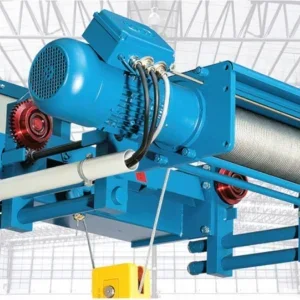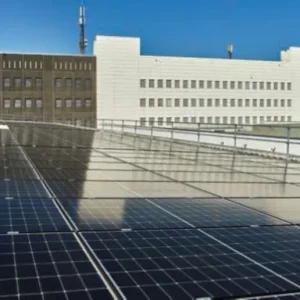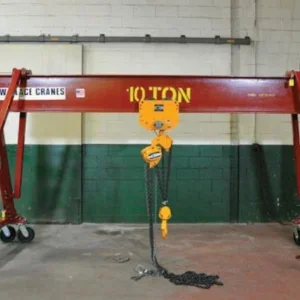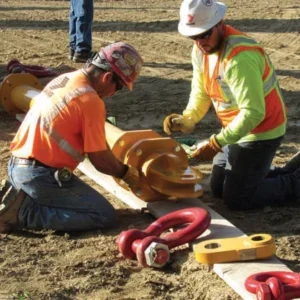Central Europe has long been the envy of nations around the world. After all, countries like Switzerland, Germany and Austria boast high living standards, developed economies and well-funded welfare states.
However, global political and economic insecurity—fuelled by the protectionist policies of the US—as well an uncertainty in Europe over Brexit and the future of the European Union, has led to some stagnation of key industrial sectors in this region.
This sobering prognosis is having an effect on sales of hoists, as confirmed by Oliver Riese, export manager at German crane manufacturer Kuli, which is based in North Rhine-Westphalia, in the west of the country. “The European markets in most areas are still weaker than they are in other regions of the world,” he says.
“Brexit has caused significant insecurity and prevented companies from investing. As a consequence, maintenance and service of existing technology is increasing and, as we are active in this segment, we are able to profit from this kind of change in the market.”
Challenges in the region have been made worse by a slight decline in Germany’s economy, which Riese says was “mainly caused by international trade restrictions”.
“In spite of this, our home market was very strong this year, even though North Rhine-Westphalia’s economy is strongly linked to the UK. The problems in Britain don’t seem to have had a significant influence on our customers in this region.”
Supplying a wide range of crane products, including hoists, wheel bogies and controls, Kuli’s business is divided into two main segments: the sale of complete cranes and the supply of crane kits, where the company additionally works with third parties.
“In the market for complete cranes we are facing a trend of individualisation,” notes Oliver Kempkes, managing director at the company. “These days, customers may have an idea about—for example—the intralogistics of a crane, and we can offer a turnkey solution to meet these needs. Because our technology is designed with a modular construction in mind, and with a high level of engineering expertise, we are able to supply such turnkey systems at competitive prices.”
Kempkes adds that safety and durability continue to be two buzzwords for its customers in Central Europe. “The robustness of our equipment is a deciding factor for many, as well as the fact that we manufacture all parts, including motors, gears, pinions, drums, and controls, out our own facilities in Remscheid, Germany,” he explains. “Customers often note that by ‘making instead of buying’, we are able to secure the consistent quality of our products.”
Specifically, the company says that its inverter-controlled crane—featuring an energy recovery system—is becoming more and more popular in the region, thanks to rising energy costs.
In terms of the industries driving demand, Kempkes notes that Kuli continues to have a strong business relationship with steel mills and the warehousing sector, while it has also recently supplied projects in the fields of prefabricated concrete parts, cement works, tools fabrication, and for large infrastructural projects.
“All of our equipment is made to be incredibly robust, so we are also heavily involved in projects where our cranes are used in harsh environments,” adds Kempkes.
Currently, the company is working on a number of large-scale projects in the region, including an infrastructure improvement programme that involves the use of a large gantry crane to move huge quantities of soil as part of an almost 24/7 excavation process.
“We are also involved in a large crane project for loading and unloading steel slabs from trains and vessels,” says Kempkes. “This crane will have a rotary table for turning those large parts around, which is necessary for optimum storage. A further challenge here is that a small hook design was requested to use the limited amount of space available in the most effective way.”
Along with some economic unpredictability in the region, Kempkes says that another issue facing the company is the difficulty of recruiting skilled workers in Germany. “This is not only because of the high level of employment in the country, but also because more and more students are choosing to go onto further study, instead of starting an apprenticeship,” he says.
However, despite some cause for concern, Kempkes concludes that most of the company’s order books, especially in Germany, are currently filled. “We are convinced that there are many reasons to be optimistic for the future.”
The rise of e-Mobility
Another German company successfully grappling with a sluggish European economy is Vollert, which supplies a range of industries including the automotive and steel and aluminium production sectors.
“The mechanical engineering industry in Europe will probably have to adjust to a weakening world economy,” explains Jens Tangel, senior sales manager at Vollert, which is based at Weinsberg, about 50km north of Stuttgart.
“The trade dispute between the US and China and growing protectionism around the globe are currently slowing order intake slightly. However, structural change— digitalisation, new forms of mobility, such as electric forms of transportation, and CO2-neutral production—offers Germany, in particular, many opportunities for innovative, well-positioned companies like Vollert.”
Founded in 1925 and with a global supply network, Vollert has recently been selling its technology to a wide range of industries, including metals manufacturing, the commercial vehicle category, and sectors that require heavy-duty intralogistics systems.
“In the steel and aluminium sector, we’ve been supplying high-capacity overhead cranes and high-bay storage solutions with stacker cranes and load capacities of up to 50t,” explains Tangel. “We additionally offer special crane systems of all types and can retrofit existing installations.”
Vollert is also able to supply machinery for surface coating plants, where components are transported during the painting/powder-coating process. A recent installation in this sector saw the company retrofit a lifting and drive solution for German manufacturer Arburg, which makes injection moulding machines. Parts weighing up to 5.5t are suspended from a carrier unit and driven through a 40m-long painting plant.
Despite a broad remit and an array of recent projects, Tangel says the majority of markets in the region are currently stagnating. “There are no real growth markets in our industry,” he confirms. “However, in the automotive segment— which is a core part of the German economy—an expansion and conversion to e-mobility is currently gaining ground.
“The technologies required by this industry will certainly stimulate the market in the future, and will help the aluminum sector, both for battery production, but also for the supply of material to automotive category.”
In this area, another recent project for the company was at the Aleris aluminium processing site in Duffel, Belgium, which is one of Europe’s largest aluminium rolling plants, specialising in the manufacture of metal sheets and coils.
“We’ve been providing intralogistics systems to the aluminium industry for many years,” notes Tangel. “Our engineers developed a custom solution for this project and were able to overcome a number of challenges, like heavy loads, fast turnaround times, and automated transport of coils with and without a reel.
“The system also had to be designed to handle a wide range of coil diameters, which continually change throughout the milling process.”
Coils weighing up to 25t each are lifted and transported in a high-bay warehouse at a speed of 2.5m/s by a rack feeder with a single telescopic arm. The coils are then transferred by four coil lift trucks, and a custom-built manipulator from Vollert— with slewing, hoisting, running gear, and a 19.5m span—then unloads the metal onto arriving lorries.
“The manipulator performs a number of steps automatically, with transport taking place at 1m/s with a hoisting speed of 0.5m/s,” says Tangel. “The gripper picks up the ‘eye’ of the coils at the balanced centre point via an automatic measuring system and transports them to the high-bay warehouse, a separate buffer warehouse, or directly to the mill as required.
“The manipulator also serves an oven and, after being treated, the hot aluminium coils—which can reach temperatures of up to 500°C—return to the warehouse to cool down.”
Like Oliver Kempkes at Kuli, Tangel has a positive outlook for the region in 2020. “We are currently in the process of negotiating a number of potential future projects and think that some of these investments will be realised at the beginning of 2020,” he says.
Oil, Gas, and Green energy
Central Europe remains a key area for Kito Europe—headquartered in Düsseldorf, Germany—with the company reporting positive sales in the region over the last few years.
“This region is a major part of our business and one of our core strengths,” says Gerasimos Koutsouvelis, sales director at the company. “Of course, Germany is a big part of our success in the region, although we are now increasing our presence in a number of other markets.”
The company has updated its product portfolio to include light crane systems from Kito Erikkila, which adds to its existing range, and allows the opportunity to “cover more of the needs of our partners and end users in the region”.
Key user segments for the company include the industrial category, with Kito’s offering of manual chain hoists, electric chain hoists and trolleys, as well as crane systems, jib cranes or monorails, suitable for sectors such as overhead power line construction, wind turbines, and for applications in the food, beverage and pharmaceutical industries.
“The industrial sector in this region is really important for us,” explains Koutsouvelis, “but we are also expanding into the oil and gas market and the power sector through our Kito Van Leusden range.”
The acquisition of the Van Leusden business has allowed Kito to enhance its portfolio of products for specialised environments, including anti-corrosion solutions that can be used offshore, and spark-proof systems that operate in areas where there is high risk of fire, including petrochemical plants and mines.
Another factor helping the company to expand its remit in the region is its recent purchase of lifting chains and accessories supplier Weissenfels, which has enabled the company to supply a wider range of chains, chain slings, and other ancillary equipment.
At present, Koutsouvelis says that customers are demanding greater operator safety—always a key goal in the hoist sector—along with technology that’s easy to use and has smooth and stable operation.
“Our electric chain hoists, for example, have an inverter as a standard feature, not an option,” he adds. “This helps to enable safe and precise lifting.”
Customers are also asking for more bespoke solutions, says Koutsouvelis, which Kito can now supply thanks to a range of business units that offer a range of different equipment types.
“We are able to supply tailor made solutions to customers for all hoisting and lifting applications—from 0.5t trolleys to gantry cranes with an SWL of up to 100t,” adds Koutsouvelis.
“Our products can be manually, electrically, pneumatically or hydraulically driven in combination with a friction wheel, rack and pinion or chain drives. We can also provide special treatments such as noncorrosive and ATEX specifications.”
Koutsouvelis says that is hard to quantify which end-use markets are currently expanding or contracting in the region, as each sector differs from country to country. “Logistics and energy companies are growing and changing with more of a focus on wind power and a green approach,” he explains.
“From my point of view, countries and companies who adjust their economies and their industries to the changing marketplace are the ones that are now developing quite well and, in contrast, those that don’t adapt are one step behind.
“However, sales growth is not just something that we experience in developing economies, because an innovative product has the ability to take market share in a region that is not performing well. That’s where Kito has tried to stay ahead of the market by enhancing our product development and by engineering more reliable solutions for our partners.”
Koutsouvelis is positive the market in the region will continue to grow, with Kito increasing its share. “We want to believe that both Central Europe and the wider European market will face a development stage, with continued long-term growth, and a priority focus on safety, as well as a cooperative approach between companies and universities in order to train the next generation of operators.”






